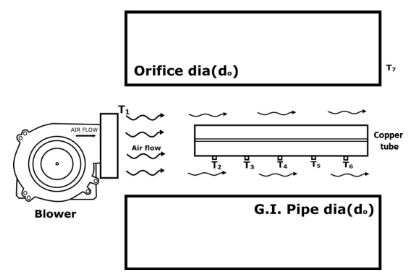Heat Transfer Coefficient in Forced Convection
INTRODUCTION
User Objectives and Goals:
- To determine Mass Density of air
- To determine Heat transfer rate
- To determine heat transfer coefficient
- To determine Vair in the tube
- To determine Vair at orifice
Theory
A hot plate of metal will cool faster from a fan than when exposed to atmosphere. The heat is convected away and the process is called as convective heat transfer. The velocity at which air blows over the hot plate obviously influences the heat transfer rate. Fig 1 shows the experimental setup that demonstrates Heat transfered by Forced Convection. This apparatus illustrates the principles of forced convection heat transfer. A blower directs air over a heated cylindrical test section, while temperature sensors measure both the surface and air temperatures. The control panel contains instruments that monitor power input and airflow. By adjusting the airflow and heat levels, we can study the relationship between flow rate and heat transfer. This setup enables the experimental determination of the convective heat transfer coefficient.

Fig 1. Experimental Setup of Heat transfered by Forced Convection

Fig 2. Schematic representation of forced convective heat transfer
Fig 2 shows the schematic representation of forced convective heat transfer.
The Newton‟s law of cooling in convective heat transfer is given by
Where, = heat transfer rate,
= surface area of heat flow,
=overall temperature difference between the wall and fluid in
= convective heat transfer coefficient $(W/m^2
⁰C)$.
The convective heat transfer coefficient depends upon the viscosity of the fluid in addition to its dependence on the thermal properties of the fluid (thermal conductivity, specific heat, density, etc). If a heated plate is exposed to ambient room air without all external source of motion, movement of air would be experienced as a result of the density gradient heat near plate. We call this natural or free convection. If the convection is experienced the case of the fan blowing air over a plate, we call this forced convection
